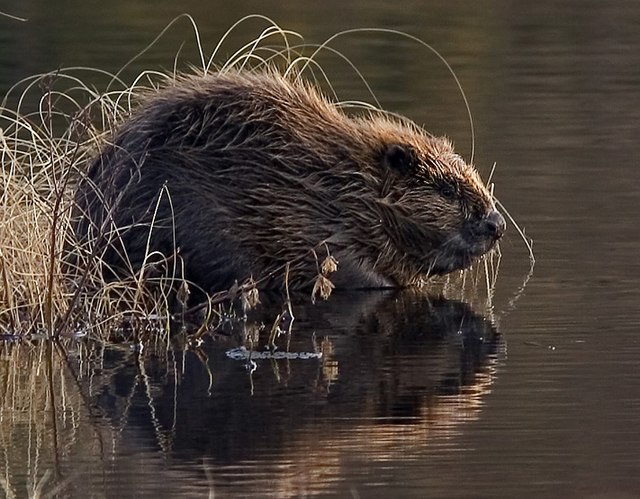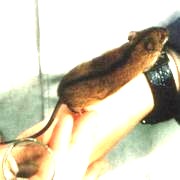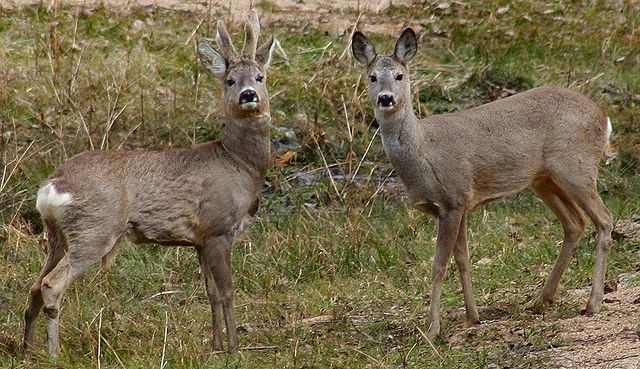Top Qs
Timeline
Chat
Perspective
List of mammals of Lithuania
From Wikipedia, the free encyclopedia
Remove ads
A list of mammals of Lithuania published in 1997 contains 68 species that are present in the country, including 14 bat species, 21 rodents, four shrews, two lagomorphs, one hedgehog, 13 carnivores, five whales and eight ungulates.[1]
The following tags are used to highlight each species' conservation status as assessed on the IUCN Red List:
| EX | Extinct | No reasonable doubt that the last individual has died. |
| EW | Extinct in the wild | Known only to survive in captivity or as naturalized populations well outside its previous range. |
| CR | Critically endangered | The species is in imminent risk of extinction in the wild. |
| EN | Endangered | The species is facing an extremely high risk of extinction in the wild. |
| VU | Vulnerable | The species is facing a high risk of extinction in the wild. |
| NT | Near threatened | The species does not meet any of the criteria that would categorise it as risking extinction but it is likely to do so in the future. |
| LC | Least concern | There are no current identifiable risks to the species. |
| DD | Data deficient | There is inadequate information to make an assessment of the risks to this species. |
Some species were assessed using an earlier set of criteria. Species assessed using this system have the following instead of near threatened and least concern categories:
| LR/cd | Lower risk/conservation dependent | Species which were the focus of conservation programmes and may have moved into a higher risk category if that programme was discontinued. |
| LR/nt | Lower risk/near threatened | Species which are close to being classified as vulnerable but are not the subject of conservation programmes. |
| LR/lc | Lower risk/least concern | Species for which there are no identifiable risks. |
Remove ads
Order: Rodentia (rodents)
Summarize
Perspective



Rodents make up the largest order of mammals, with over 40% of mammalian species. They have two incisors in the upper and lower jaw which grow continually and must be kept short by gnawing. Most rodents are small though the capybara can weigh up to 45 kg (100 lb).
- Suborder: Sciurognathi
- Family: Castoridae (beavers)
- Genus: Castor
- Eurasian beaver, C. fiber LC[2]
- Genus: Castor
- Family: Sciuridae (squirrels)
- Subfamily: Sciurinae
- Family: Gliridae (dormice)
- Subfamily: Leithiinae
- Genus: Dryomys
- Forest dormouse, D. nitedula LC
- Genus: Eliomys
- Garden dormouse, Eliomys quercinus VU
- Genus: Muscardinus
- Hazel dormouse, Muscardinus avellanarius LR/nt
- Genus: Dryomys
- Subfamily: Glirinae
- Genus: Glis
- European edible dormouse, Glis glis LR/nt
- Genus: Glis
- Subfamily: Leithiinae
- Family: Cricetidae
- Subfamily: Arvicolinae
- Genus: Arvicola
- Water vole, Arvicola terrestris LR/lc
- Genus: Clethrionomys
- Bank vole, Clethrionomys glareolus LR/lc
- Genus: Microtus
- Field vole, Microtus agrestis LR/lc
- Common vole, Microtus arvalis LR/lc
- Genus: Arvicola
- Subfamily: Arvicolinae
- Family: Muridae (mice, rats, voles, gerbils, hamsters, etc.)
- Subfamily: Murinae
- Genus: Apodemus
- Striped field mouse, Apodemus agrarius LR/lc
- Yellow-necked mouse, Apodemus flavicollis LR/lc
- Wood mouse, Apodemus sylvaticus LC
- Genus: Micromys
- Harvest mouse, Micromys minutus LR/nt
- Genus: Apodemus
- Subfamily: Murinae
- Family: Castoridae (beavers)
Remove ads
Order: Lagomorpha (lagomorphs)

The following two lagomorphs are present in the country:[1]
- Family: Leporidae (rabbits, hares)
- Genus: Lepus
- European hare, L. europaeus LC[3]
- Mountain hare, L. timidus LC[4]
- Genus: Lepus
Order: Erinaceomorpha (hedgehogs and gymnures)

The order Erinaceomorpha contains a single family, Erinaceidae, which comprise the hedgehogs and gymnures. The hedgehogs are easily recognised by their spines while gymnures look more like large rats.
- Family: Erinaceidae (hedgehogs)
- Subfamily: Erinaceinae
- Genus: Erinaceus
- Southern white-breasted hedgehog, Erinaceus concolor LR/lc
- West European hedgehog, Erinaceus europaeus LR/lc
- Genus: Erinaceus
- Subfamily: Erinaceinae
Order: Soricomorpha (shrews, moles, and solenodons)

The following four shrew species are present in the country:[1]
- Family: Soricidae (shrews)
- Subfamily: Soricinae
- Tribe: Soricini
- Genus: Sorex
- Common shrew, S. araneus LC[5]
- Eurasian pygmy shrew, S. minutus LC[6]
- Genus: Neomys
- Eurasian water shrew, N. fodiens LC
- Genus: Sorex
- Tribe: Soricini
- Subfamily: Soricinae
- Family: Talpidae (moles)
- Subfamily: Talpinae
- Tribe: Talpini
- Genus: Talpa
- European mole, T. europaea LC
- Genus: Talpa
- Tribe: Talpini
- Subfamily: Talpinae
Order: Chiroptera (bats)
The bats' most distinguishing feature is that their forelimbs are developed as wings, making them the only mammals capable of flight. Bat species account for about 20% of all mammals.
- Family: Vespertilionidae
- Subfamily: Myotinae
- Subfamily: Vespertilioninae
- Genus: Barbastella
- Western barbastelle, B. barbastellus NT[7]
- Genus: Nyctalus
- Lesser noctule, Nyctalus leisleri LR/nt
- Genus: Pipistrellus
- Common pipistrelle, Pipistrellus pipistrellus LC
- Genus: Barbastella
Remove ads
Order: Cetacea (whales)
Summarize
Perspective

The order Cetacea includes whales, dolphins and porpoises. They are the mammals most fully adapted to aquatic life with a spindle-shaped nearly hairless body, protected by a thick layer of blubber, and forelimbs and tail modified to provide propulsion underwater.
- Suborder: Mysticeti
- Family: Balaenidae (right whales)
- Genus: Balaena
- North Atlantic right whale, Eubalaena glacialis CR or functionally extinct in the eastern Atlantic'[8]
- Genus: Balaena
- Family: Balaenopteridae
- Subfamily: Balaenopterinae
- Genus: Balaenoptera
- Subfamily: Megapterinae
- Genus: Megaptera
- Humpback whale, Megaptera novaeangliae LC[9][10][11]
- Genus: Megaptera
- Subfamily: Balaenopterinae
- Family: Balaenidae (right whales)
- Suborder: Odontoceti
- Family: Phocoenidae
- Genus: Phocoena
- Harbour porpoise, Phocoena phocoena VU
- Genus: Phocoena
- Family: Monodontidae
- Genus: Delphinapterus
- Family: Ziphidae
- Genus: Mesoplodon
- Sowerby's beaked whale, Mesoplodon bidens DD[14]
- Genus: Mesoplodon
- Family: Delphinidae (marine dolphins)
- Genus: Lagenorhynchus
- White-beaked dolphin, Lagenorhynchus albirostris LR/lc
- Genus: Tursiops
- Bottlenose dolphin, Tursiops truncatus DD[15]
- Genus: Grampus
- Risso's dolphin, Grampus griseus DD
- Genus: Orcinus
- Genus: Lagenorhynchus
- Family: Phocoenidae
Remove ads
Order: Carnivora (carnivorans)

There are over 260 species of carnivorans, the majority of which feed primarily on meat. They have a characteristic skull shape and dentition.
- Suborder: Feliformia
- Family: Felidae (cats)
- Subfamily: Felinae
- Genus: Lynx
- Eurasian lynx, L. lynx LC[17]
- Genus: Lynx
- Subfamily: Felinae
- Family: Felidae (cats)
- Suborder: Caniformia
- Family: Canidae (dogs, foxes)
- Family: Mustelidae (mustelids)
- Genus: Lutra
- European otter, L. lutra NT[20]
- Genus: Martes
- European pine marten, M. martes LC
- Genus: Meles
- European badger, M. meles LC[21]
- Genus: Mustela
- Least weasel, M. nivalis LC[22]
- Stoat, M. erminea LC[23]
- European polecat, M. putorius LC
- Genus: Neogale
- American mink, N. vison LC introduced[24]
- Genus: Lutra
- Family: Phocidae (earless seals)
- Genus: Halichoerus
- Gray seal, Halichoerus grypus LC
- Genus: Halichoerus
Remove ads
Order: Artiodactyla (even-toed ungulates)

The even-toed ungulates are ungulates whose weight is borne about equally by the third and fourth toes, rather than mostly or entirely by the third as in perissodactyls. There are about 220 artiodactyl species, including many that are of great economic importance to humans.
Remove ads
Locally extinct
The following species are locally extinct in the country:
- European mink, Mustela lutreola[1][30]
- Siberian flying squirrel, Pteromys volans[1][31]
- Brown bear, Ursus arctos[1][32]
See also
References
External links
Wikiwand - on
Seamless Wikipedia browsing. On steroids.
Remove ads